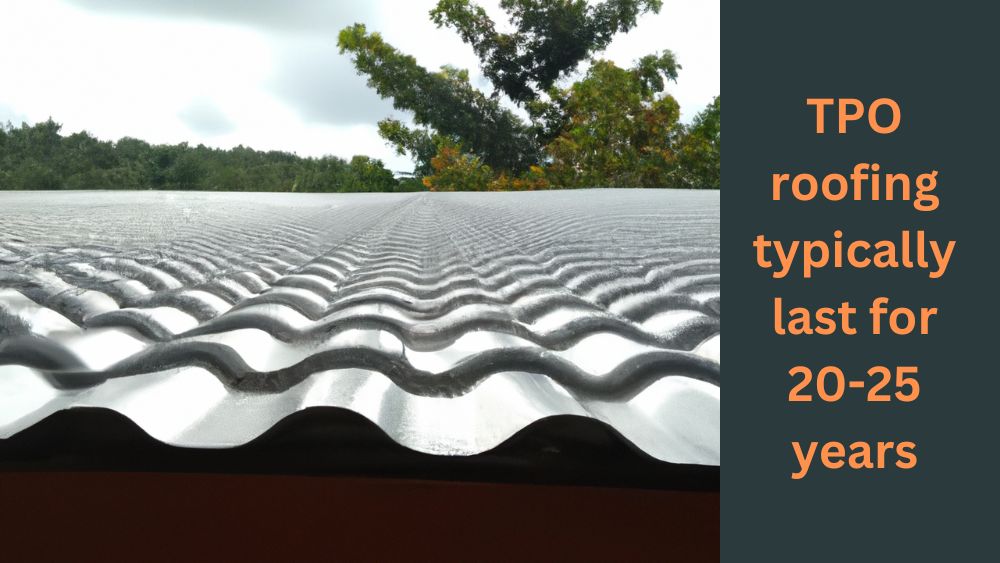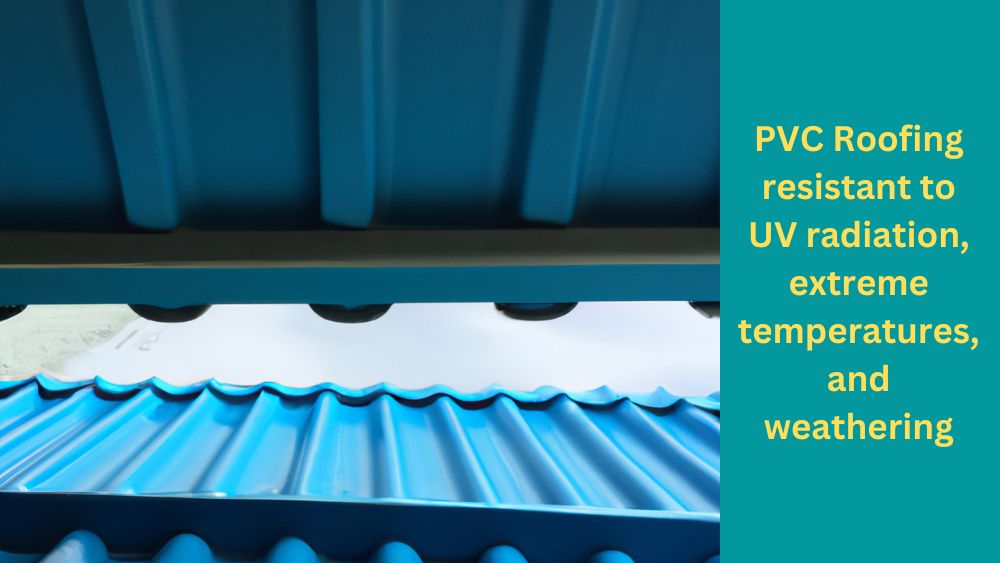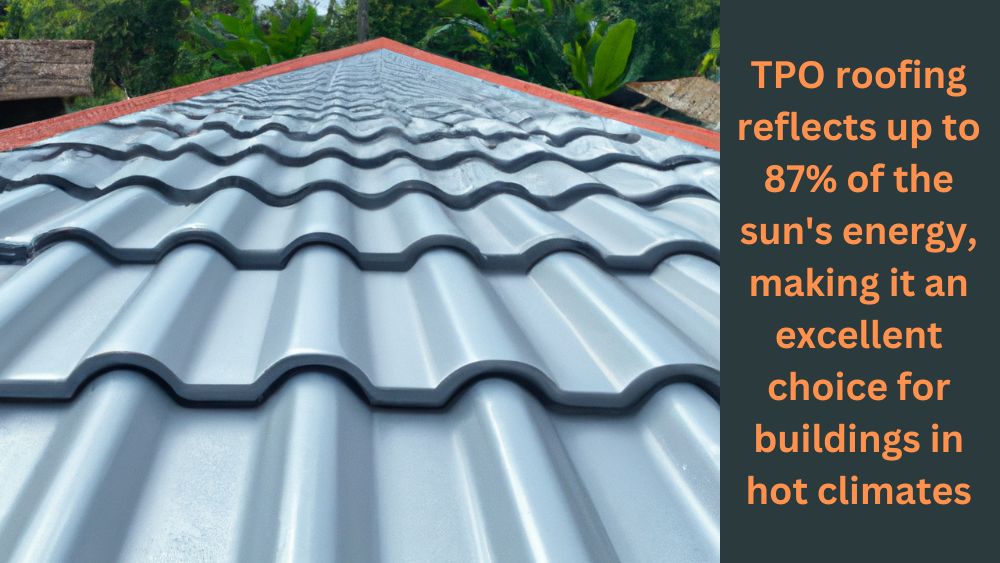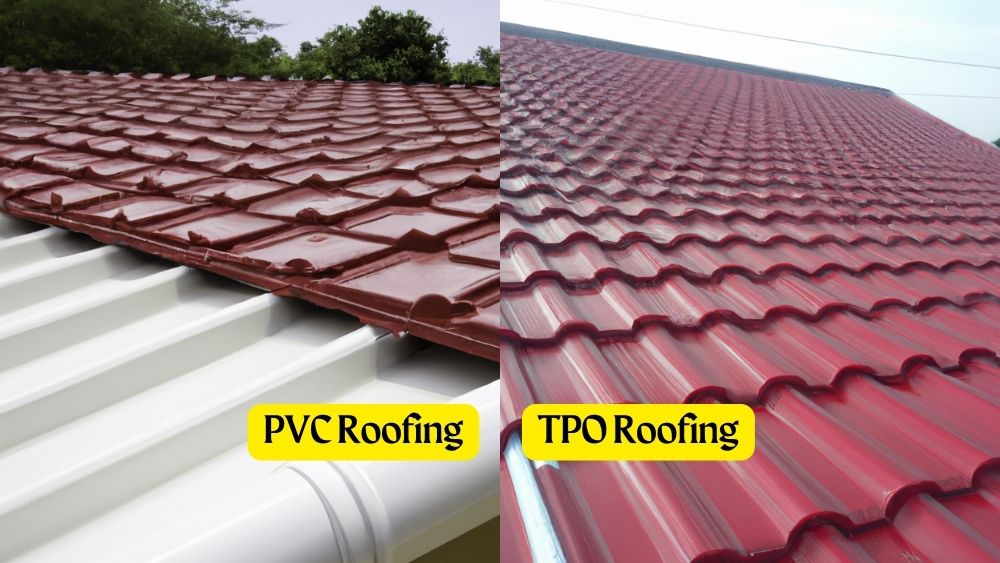PVC and TPO roofing are durable, weather-resistant options suitable for various buildings. They are both made from synthetic materials and are known for their energy-efficient properties, as they reflect sunlight and help to reduce the amount of heat absorbed by the building. However, there are some key differences between PVC and TPO roofing, including their cost, lifespan, and installation process.
TPO Roofing
TPO (thermoplastic olefin) roofing is a type of roofing system made from thermoplastic olefin, a synthetic rubber material. It is used on flat and low-sloped roofs and is known for its durability, versatility, and cost-effectiveness.
PVC Roofing
PVC (polyvinyl chloride) roofing is a type of roofing system made from polyvinyl chloride, a synthetic plastic material. It is used on flat and low-sloped roofs and is known for its durability, versatility, and cost-effectiveness.

Comparison of TPO and PVC roofing
PVC (polyvinyl chloride) and TPO (thermoplastic olefin) are both roofing systems used in the construction industry. While they have some similarities, there are also some critical differences. Here is a comparison of PVC and TPO roofing:
Durability
Regarding durability, TPO and PVC roofing is known for their strength and resistance to wear and tear. TPO roofing is known for its exceptional resistance to UV radiation, which can cause other roofing materials to deteriorate over time. It is also highly resistant to chemicals, making it a good choice for industrial settings where chemical spills may occur. PVC roofing is resistant to UV radiation, extreme temperatures, and weathering, making it a good choice for commercial and residential settings.
Lifespan
TPO and PVC roofing have long lifespans, with TPO roofing typically lasting for 20-25 years and PVC roofing lasting up to 30 years or more. However, it is worth noting that the lifespan of any roofing material will depend on various factors, such as the quality of the material, the thickness of the roofing, and the frequency of maintenance and repairs.
Energy efficiency
TPO and PVC roofing is known for their energy-efficient properties, as they reflect UV radiation and help reduce the temperature inside the building. This can lower energy costs and improve the overall comfort of the building.
However, TPO roofing is generally considered more energy-efficient than PVC roofing due to its higher reflectivity. TPO roofing reflects up to 87% of the sun’s energy, making it an excellent choice for buildings in hot climates.
Resistance to weather
TPO and PVC roofing is resistant to extreme weather conditions, including high winds, hail, and heavy rain. TPO roofing is incredibly resistant to UV radiation and extreme temperatures, making it a good choice for buildings in areas with hot climates. It is also resistant to chemical spills, making it a good choice for industrial settings.
PVC roofing is also resistant to extreme weather conditions, including high winds, hail, and heavy rain. It is highly resistant to UV radiation, extreme temperatures, and weathering, making it a good choice for commercial and residential settings.
Repair and maintenance
TPO and PVC roofing requires regular maintenance to ensure they are in good condition and functioning correctly. This may include cleaning the roof, checking for and repairing any damages, and inspecting the roof for signs of wear and tear. TPO roofing is generally easier to repair and maintain than PVC roofing due to its flexibility. It is also resistant to chemicals, which can make it easier to clean and maintain.
PVC roofing is also easy to maintain and repair, although it may require more frequent maintenance due to its more rigid nature. It is essential to hire a professional to repair or maintain your PVC roof, as improper repairs or maintenance can cause damage to the roof.
Cost
Generally speaking, PVC roofs tend to be more expensive than TPO roofs. The price difference can vary according to project size, location, required labor, etc., but it’s safe to assume that you will pay more for PVC than TPO roofing systems. Depending on the thickness of the membrane, TPO roofs can cost anywhere between $5 and $11. Depending on the thickness of the membrane, a PVC roof can cost from $6 to $12 per square foot
Environmental impact
TPO and PVC offer strong eco credentials regarding roof materials – although they each have their advantages. Generally, TPO roofing is usually considered the most eco-friendly due to its energy efficiency qualities and because it contains no harmful compounds or volatile organic compounds (VOCs). Meanwhile, traditional PVC is made from synthetic plastics derived from oil derivatives, which produces some greenhouse gas emissions during production. However, there are now recyclable versions available.

Pros and cons of TPO roofing
Advantages
- Affordable to install and maintain
- Durable and resistant to UV radiation, chemicals, and extreme weather conditions
- Energy-efficient and helps to reduce energy costs
- Easy to repair and maintain
- Environmentally friendly, as it is made from recycled materials and is fully recyclable
Disadvantages
- May not be as visually appealing as some other roofing materials
- May not be suitable for all climates, as it can become brittle in cold temperatures
Pros and cons of PVC roofing
Advantages
- Durable and has a long lifespan of up to 30 years or more
- Resistant to UV radiation, extreme temperatures, and weathering
- Energy-efficient and helps to reduce energy costs
- Easy to repair and maintain
- Lightweight but durable
Disadvantages
- More expensive to install than TPO roofing
- May not be as flexible as some other roofing materials, which can make it more difficult to repair
- Less eco-friendly than TPO roofing
- Requires regular maintenance to ensure that it is in good condition
Factors to consider when choosing between TPO and PVC roofing
There are several factors to consider when choosing between TPO and PVC roofing for your home or business. These include:
Climate
The climate in your area can play a significant role in determining which type of roofing is the best for your building. TPO roofing is generally a better choice for buildings in hot climates, as it is highly resistant to UV radiation and extreme temperatures. PVC roofing is a good choice for both hot and cold climates, as it is resistant to UV radiation, extreme temperatures, and weathering.
Building type
The type of building you are roofing will also be a factor to consider. TPO roofing is generally a good choice for commercial and industrial buildings, as it is durable and resistant to chemicals. PVC roofing is a good choice for both commercial and residential buildings, as it is durable and has a long lifespan.
Budget
Your budget will also be a factor to consider when choosing between TPO and PVC roofing. TPO roofing is generally more affordable to install and maintain than PVC roofing, although the initial cost may vary depending on the size and complexity of the roofing project. It is essential to carefully consider your budget and potential long-term costs when deciding which type of roofing is the best for your building.

Membrane Thickness PVC vs. TPO
In general, PVC roofing membranes are typically thicker than TPO roofing membranes. PVC roofing membranes are typically available in thicknesses ranging from 45 mils to 80 mils, while TPO roofing membranes are typically available in thicknesses ranging from 45 mils to 70 mils. The exact thickness will depend on the manufacturer and the specific product.
Fire Resistance, PVC vs. TPO roofing
We all are concerned about fire. Therefore when we buy roofing material, we should consider fire-resistant roofing. You are sure that PVC and TPO will not be resistant enough when the fire is furious! But our curious minds want to know which is comparatively better.
Compared to TPO, PVC has a higher fire retardant rating due to its chlorine content. That’s why commercial buildings often have PVC roofs – the chlorine puts out fires. PVC can emit toxic fumes when burned, so please be aware.
Synthetic rubber, such as TPO, is excellent in roofing because it’s lightweight and easy to install. On top of that, it’s got fire-resistant properties on its outward-facing surface – unlike PVC, which has protection on all sides. TPO will catch fire if exposed to an open flame, but the fire need not originate from the top. The flames in a kitchen fire will come from underneath the TPO, where there is no fire retardant. TPO also emits some nasty toxic fumes when burned.
Want to know which roofing material is better for fire safety? PVC roofing has a higher level of fire resistance than TPO roofing because it’s more resistant to chemicals. But both can still provide a degree of protection from fires. PVC is the better choice.

FAQS
How do I maintain TPO roofing?
TPO roofing requires only occasional inspections and basic repairs to maintain its durability and longevity. It is easy to clean and can be repaired with a patch or patch kit.
Can TPO roofing be repaired?
Yes, you can repair TPO roofing with a patch or patch kit. You need to fix any damages or leaks as soon as possible to prevent further damage to the roof.
Can TPO roofing be used in cold climates?
TPO roofing is suitable for use in cold climates as it can withstand extreme temperatures and is resistant to frost damage.
Can TPO roofing be used on residential buildings?
Yes, TPO roofing is suitable for residential and commercial buildings. It is a popular choice for residential roofing due to its durability, versatility, and cost-effectiveness.
Can TPO roofing be installed over an existing roof?
Yes, TPO roofing can be installed over an existing roof, provided that the roof is in good condition and can support the weight of the new roofing system. You may need to consult a professional roofing contractor to determine if this is viable for your building.
Is TPO roofing suitable for use on steep-sloped roofs?
TPO roofing is primarily designed for use on flat and low-sloped roofs. While you can use it on steep-sloped roofs, it may provide a different level of protection than other roofing materials specifically designed for steep slopes. It is important to consult with a professional roofing contractor to determine the best roofing solution for your building.
Can PVC roofing be installed on any roofing surface?
PVC roofing can be installed on various roofing surfaces, including flat and low-sloped roofs, making it a suitable choice for many buildings.
Is PVC roofing resistant to algae and mold growth?
PVC roofing has a smooth surface resistant to algae and mold growth. However, it is still essential to keep the roof clean and well-maintained to prevent the growth of these organisms.
Can PVC roofing be used in areas with high winds?
Yes, PVC roofing is suitable for use in areas with high winds as it is resistant to wind damage. You have to follow proper installation guidelines and use mechanical fasteners or adhesives to secure the roofing membrane to the roof.
Can PVC roofing be painted?
Yes, PVC roofing can be painted to match the color of the building or to add an extra layer of protection.
Can PVC roofing be installed over an existing roof?
Yes, PVC roofing can be installed over an existing roof, provided that the roof is in good condition and can support the weight of the new roofing system.
Is PVC roofing suitable for use on steep-sloped roofs?
PVC roofing is primarily designed for use on flat and low-sloped roofs. While you can use it on steep-sloped roofs, it may provide a different level of protection than other roofing materials specifically designed for steep slopes.
Conclusion
In conclusion, TPO and PVC roofing is durable and reliable options for protecting your home or business. TPO roofing is known for its affordability, durability, and energy efficiency, while PVC roofing is known for its durability, long lifespan, and resistance to weathering.
When choosing between TPO and PVC roofing, you should consider the climate, building type, and budget, as well as the specific needs of your building. Also, you should hire a professional to install and maintain your roof to ensure it is in good condition and functioning correctly. Overall we suggest TPO for overall performance.

